buttons PEUGEOT 108 2015 Owners Manual
[x] Cancel search | Manufacturer: PEUGEOT, Model Year: 2015, Model line: 108, Model: PEUGEOT 108 2015Pages: 271, PDF Size: 7.42 MB
Page 27 of 271
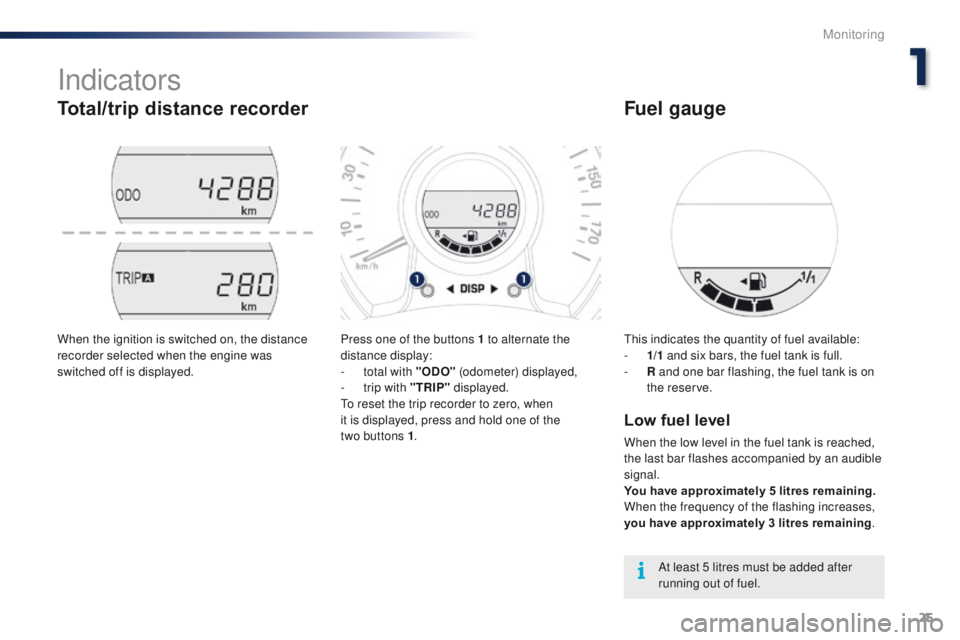
25
108_en_Chap01_controle-de-marche_ed01-2015
Indicators
Total/trip distance recorder
Press one of the buttons 1 to alternate the
distance display:
-
t
otal with "ODO" (odometer) displayed,
-
t
rip with "TRIP" displayed.
to r
eset the trip recorder to zero, when
it is displayed, press and hold one of the
two
buttons 1 .
When the ignition is switched on, the distance
recorder selected when the engine was
switched off is displayed.th
is indicates the quantity of fuel available:
- 1/ 1 and six bars, the fuel tank is full.
-
R
and one bar flashing, the fuel tank is on
the reserve.
Low fuel level
When the low level in the fuel tank is reached,
the last bar flashes accompanied by an audible
signal.
You have approximately 5 litres remaining.
When the frequency of the flashing increases,
you have approximately 3 litres remaining .
Fuel gauge
At least 5 litres must be added after
running out of fuel.
1
Monitoring
Page 28 of 271

26
tr i p c o m p u t e r
System that gives you information on the journey in progress (range, fuel consumption…).
Information display
F Press one of theses buttons to display the various trip computer tabs in turn:
-
t
h
e total distance.
-
t
h
e trip "A".
-
t
h
e trip "B" .
-
t
h
e Stop & Start partial time counter*.
-
t
h
eStop & Start global time counter*.
-
t
h
e ambient temperature*.
-
t
h
e current fuel consumption.
-
t
h
e average fuel consumption.
-
t
he
remaining range.
-
t
h
e average speed.
-
t
h
e lighting dimmer.
Trip reset
F When the trip required is displayed, press one of the two buttons for more than
two
seconds.
t
r i p s "A" and "B" are independent but their
use is identical.
For example, trip "A" can be used for daily
figures, and trip "B" for monthly figures.
* Depending on version.
Lighting dimmer
When driving at night, this function allows
certain displays in the instrument panel to be
switched off to reduce visual fatigue for the
driver.
It operates only when the sidelamps are on.
F
W
hen the "Lighting dimmer" menu is
displayed, press and hold one of the
buttons for access to the adjustment.
F
t
h
en make repeated presses on one of
the two buttons to increase or reduce the
brightness.
t
h
e display flashes to show you the
brightness chosen.
Monitoring
Page 33 of 271
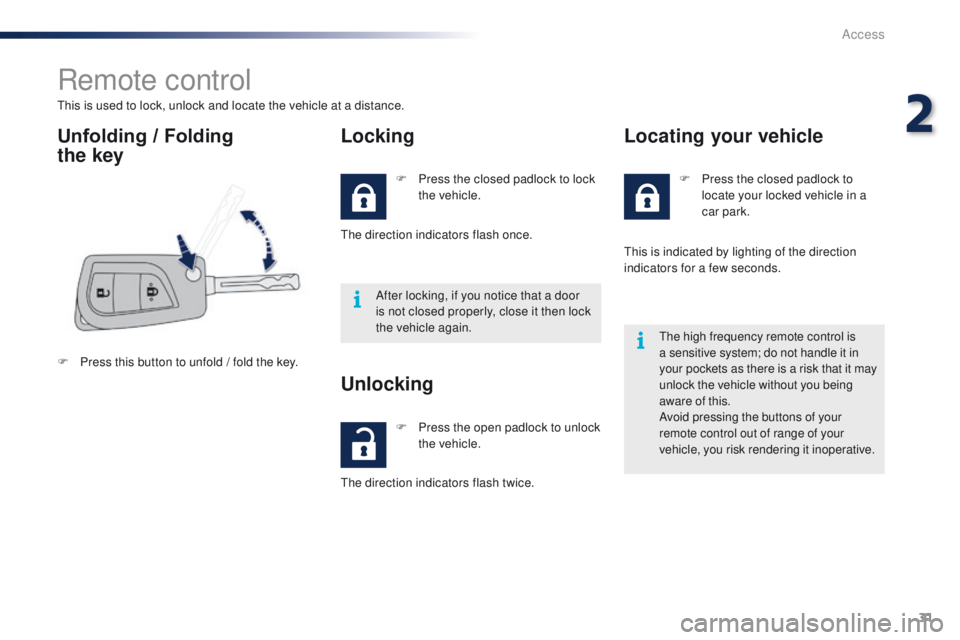
31
108_en_Chap02_ouvertures_ed01-2015
Remote control
this is used to lock, unlock and locate the vehicle at a distance.
Unfolding / Folding
the key Locking
F Press this button to unfold / fold the key. F
P
ress the closed padlock to lock
the vehicle.
th
e direction indicators flash once.
After locking, if you notice that a door
is not closed properly, close it then lock
the vehicle again.
F
P
ress the open padlock to unlock
the vehicle.
Unlocking
the direction indicators flash twice. F
P
ress the closed padlock to
locate your locked vehicle in a
car park.
Locating your vehicle
this is indicated by lighting of the direction
indicators for a few seconds.
th
e high frequency remote control is
a sensitive system; do not handle it in
your pockets as there is a risk that it may
unlock the vehicle without you being
aware of this.
Avoid pressing the buttons of your
remote control out of range of your
vehicle, you risk rendering it inoperative.
2
Access
Page 35 of 271
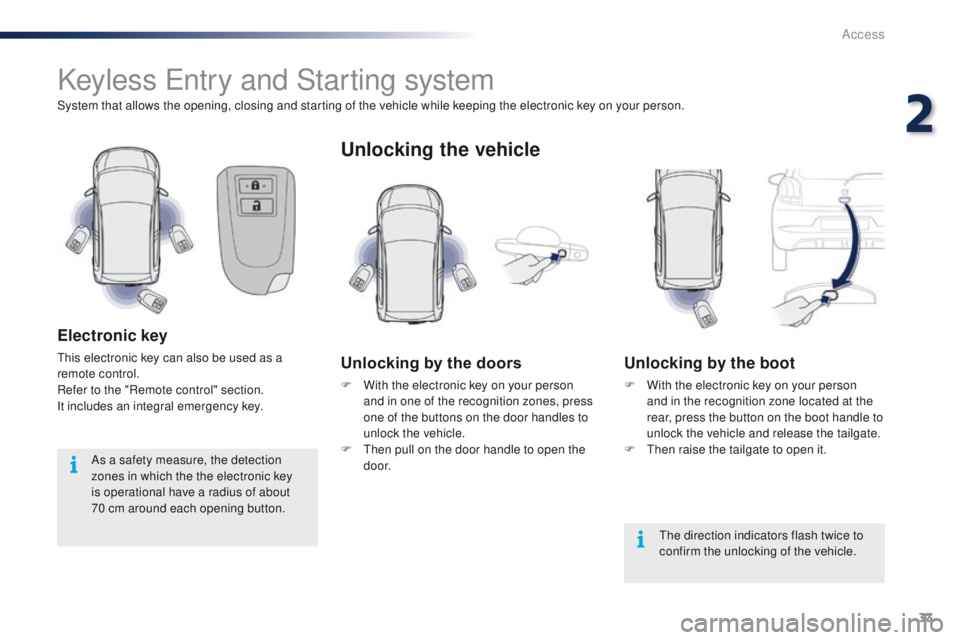
33
108_en_Chap02_ouvertures_ed01-2015
Keyless entry and Starting system
System that allows the opening, closing and starting of the vehicle while keeping the electronic key on your person.
Electronic key
this electronic key can also be used as a
remote control.
Refer to the "Remote control" section.
It includes an integral emergency key.
Unlocking the vehicle
Unlocking by the doors
F With the electronic key on your person and in one of the recognition zones, press
one of the buttons on the door handles to
unlock the vehicle.
F
t
h
en pull on the door handle to open the
d o o r.
Unlocking by the boot
F With the electronic key on your person and in the recognition zone located at the
rear, press the button on the boot handle to
unlock the vehicle and release the tailgate.
F
t
hen
raise the tailgate to open it.
th
e direction indicators flash twice to
confirm the unlocking of the vehicle.
As a safety measure, the detection
zones in which the the electronic key
is
operational have a radius of about
70
cm around each opening button.
2
Access
Page 36 of 271

34
108_en_Chap02_ouvertures_ed01-2015
Locking the vehicle
Locking
F With the electronic key in the recognition zone, press one of the buttons on the front
door handles or press the button on the
boot sill.
th
e direction indicators flash once. If one of the doors or the boot is still
open or if the electronic key for the
Keyless
e
n
try and Starting system has
been left inside the vehicle, you are
warned by an audible signal and the
central locking does not take place.
If the electronic key is left inside the
vehicle after switching off the engine,
there is a continuous audible signal on
opening the driver's door. Never expose the electronic key to
extreme temperatures (below -20°C or
above +60°C); this could cause faults.
For reasons of safety and theft
protection, do not leave your electronic
key in the vehicle, even when you are
close to it.
It is recommended that you keep it on
your person.
If the vehicle is unlocked and no door
or the boot is opened, the vehicle will
lock again automatically after about
thirty
seconds.
Access
Page 37 of 271

35
108_en_Chap02_ouvertures_ed01-2015
Emergency procedure
Unlocking
F Insert the integral key into the driver's door lock barrel and turn it towards the front of
the vehicle to unlock the vehicle.
Locking
F Insert the integral key into the driver's door lock barrel and turn it towards the rear of
the vehicle to lock the vehicle.
th
e integral key is used to lock and unlock the
vehicle when the electronic key cannot operate
and in the event of a fault with the Keyless
en
try and Starting system:
-
c
ell battery discharged, vehicle battery
discharged or disconnected, ...
-
v
ehicle located in an area with strong
electromagnetic signals.
F
P
ress and hold the latch 1 to extract the
integral key 2 .
Saving the electronic key
battery
to preserve the battery, it is possible to prevent
the electronic key working (no reception of
radio waves).
When this function is activated, the "Keyless
en
try and Starting" system is inoperative.
to r
eactivate the electronic key, press one of
the buttons (open or closed padlock). F
P
ress on the open padlock twice,
while pressing on and holding
the closed padlock.
Check that the indicator lamp in the electronic
key flashes 4 times.
2
Access
Page 38 of 271
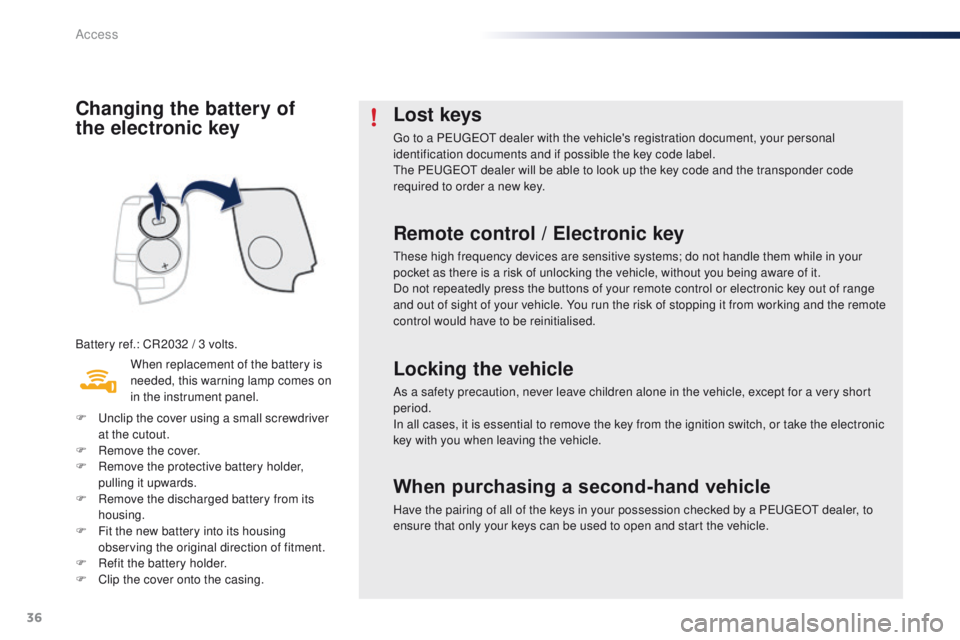
36
108_en_Chap02_ouvertures_ed01-2015
Changing the battery of
the electronic key
Battery ref.: CR2032 / 3 volts.When replacement of the battery is
needed, this warning lamp comes on
in the instrument panel.
F
u
n
clip the cover using a small screwdriver
at the cutout.
F
R
emove the cover.
F
R
emove the protective battery holder,
pulling it upwards.
F
R
emove the discharged battery from its
housing.
F
F
it the new battery into its housing
observing the original direction of fitment.
F
R
efit the battery holder.
F
C
lip the cover onto the casing.
Lost keys
go to a PeugeOt dealer with the vehicle's registration document, your personal
identification documents and if possible the key code label.
th
e P
e
uge
Ot
dealer will be able to look up the key code and the transponder code
required to order a new key.
Remote control / Electronic key
these high frequency devices are sensitive systems; do not handle them while in your
pocket as there is a risk of unlocking the vehicle, without you being aware of it.
Do not repeatedly press the buttons of your remote control or electronic key out of range
and out of sight of your vehicle. You run the risk of stopping it from working and the remote
control would have to be reinitialised.
Locking the vehicle
As a safety precaution, never leave children alone in the vehicle, except for a very short
period.
In all cases, it is essential to remove the key from the ignition switch, or take the electronic
key with you when leaving the vehicle.
When purchasing a second-hand vehicle
Have the pairing of all of the keys in your possession checked by a Pe ugeOt dealer, to
ensure that only your keys can be used to open and start the vehicle.
Access
Page 59 of 271

57
108_en_Chap03_confort_ed01-2015
For maximum cooling or heating of the
cabin, it is possible to go beyond the
minimum 14 or maximum 28 value.
F
P
ress the temperature adjustment
button down or up until "LO" or
"HI" is displayed.
A setting around 21
gives optimum comfort.
However, depending on your requirements, a
setting between 18 and 24 is normal.
On entering the vehicle, if the interior is very
cold or hot, there is no need to change the
value displayed in order to reach the required
level of comfort. t
h
e system corrects the
temperature difference automatically and as
quickly as possible.
Temperature adjustment
F Press this button downward to reduce the value and upward to
increase it.
th
e value indicated in the screen corresponds
to a level of comfort and not to a temperature in
degrees Celsius or Fahrenheit.
Air flow adjustment
F Press this button to increase air f low.
th
e air flow symbol, the fan, fills progressively. F
P
ress this button to decrease air
f low.
Air distribution adjustment
- the centre and side air vents,
- t he centre vent, side air vents and
footwells,
-
t
he footwells,
-
t
he windscreen and footwells,
-
t
he centre vent, side air vents and
windscreen,
-
t
he windscreen. F
P
ress this button repeatedly to
direct the air to:
Air intake / Air recirculation
Avoid prolonged recirculation of interior
air (risk of condensation or deterioration
of the air quality). F
P
ressing this buttons isolates the
passenger compartment from the
outside air.
t
h
e air recirculation symbol is
displayed.
Air recirculation enables the passenger
compartment to be isolated from exterior odours
and smoke.
Press this button again or press the "AUTO"
button to resume automatic management of the
intake of air. t
h
e air recirculation symbol goes off.
3
Comfort
Page 83 of 271

81
108_en_Chap05_conduite_ed01-2015
Stop & Start (Vti 68 S&S engine)
Operation
Going into engine STOP mode
this indicator lamp comes on in the
instrument panel and the engine
goes into standby automatically:
-
w
hen stationary, in neutral, and you
release the clutch pedal.
Never refuel with the engine in S
tO
P
mode; you must switch off the ignition
with the button. For smoother operation, during
parking manoeuvres S
tO
P mode is
not available for a few seconds after
coming out of reverse gear.
S
tO
P mode does not affect the
vehicle's systems, such as for example,
braking, power steering...
Special cases: STOP mode not
available
StOP mode is not invoked principally when:
- t he driver's door is open,
-
t
he driver's seat belt is not fastened,
-
t
he engine is needed to maintain a
comfortable temperature in the passenger
compartment,
-
d
emisting is active,
-
s
ome special conditions (battery charge,
engine temperature, braking assistance,
vehicle stopped on a steep gradient, high
altitude...) where the engine is needed to
assure control of a system.
th
e Stop & Start
system puts the engine temporarily into standby - S
tO
P mode - during stops in the traffic (red lights, traffic jams, or other...). t
h
e
engine restarts automatically - S
tA
R
t
mode - as soon as you want to move off.
t
h
e restart takes place instantly, quickly and silently.
Per fect for urban use, the Stop & Start system reduces fuel consumption and exhaust emissions as well as the noise level when stationary.
Stop & Start time counters
A partial time counter counts the periods in
StO P mode during a journey.
It is displayed in the trip computer once the
Stop & Start acts.
Press one of the screen management buttons
to return to the previous display.
A global time counter counts the periods in
S
tO
P mode since the last reset.
When it is displayed, press one of the screen
management buttons to reset the counter.
5
Driving
Page 186 of 271
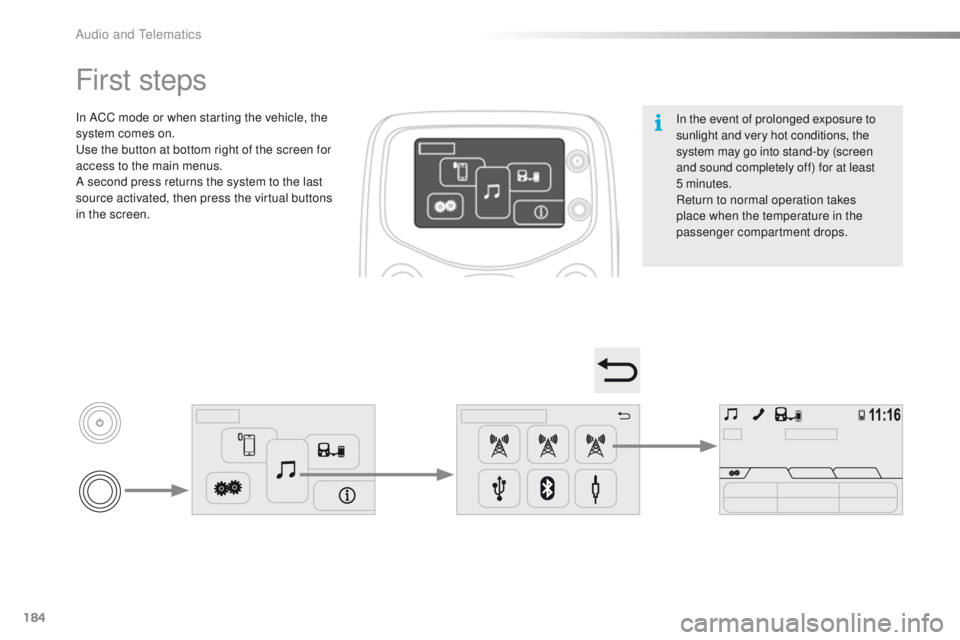
184
108_en_Chap12a_Autoradio-Toyota-tactile-1_ed01-2015
In the event of prolonged exposure to
sunlight and very hot conditions, the
system may go into stand-by (screen
and sound completely off) for at least
5 minutes.
Return to normal operation takes
place when the temperature in the
passenger compartment drops.
First steps
In ACC mode or when starting the vehicle, the
system comes on.
us
e the button at bottom right of the screen for
access to the main menus.
A second press returns the system to the last
source activated, then press the virtual buttons
in the screen.
Audio and telematics